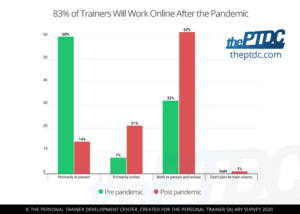 Ever hear one question from somebody, but you realize they’re asking something else?
Ever hear one question from somebody, but you realize they’re asking something else?
If someone points and says, “You gonna eat that?” They really mean, “Can I have it?”
When I hear someone asking how big the online personal training industry is, what I really hear is:
“Is there room for me?”
They’re wondering if our industry is saturated. They know that online training is popular and that it’s only getting more popular. More crowded.
But is there still opportunity? The answer is unequivocally YES.
I understand the doubt. It seems like everyone is doing it.
Trainers are increasingly taking on clients for at-home workouts. Clients who’ve been cooped up during the pandemic are eager to get their workouts in, and they want professional guidance.
For a trainer new to this world, it’s like staring at a crowded, moving train and wondering if you can jump on. Maybe you should wait for the next one?
Back to the original question …
How big is the online personal training industry?
Short answer: We don’t really know.
You won’t find official employment statistics that mean anything because lots of trainers work for cash, under the table, and don’t tell the full truth on their taxes. That’s undeniable.
Anyone who says they have accurate statistics is lying or mistaken.
But it almost doesn’t matter. It might be interesting, but it’s not important.
Here at thePTDC.com we do surveys that give us a snapshot of our industry. We do one every year on personal trainer salaries, for instance.
Last year, we did a survey to see how the COVID shutdown was affecting business.
Just before COVID hit, 39 percent of trainers said they did something online. Not necessarily full-time online, but some sort of online fitness business.
By August 2020, that number was 83 percent.
We also asked what they’d be doing once COVID ends: Only 14 percent say they’ll be primarily in the gym. That’s a 75 percent drop from previous levels.

Okay, I get it. Those numbers sound discouraging. It does seem that everyone’s already defining themselves as online fitness professionals, or thinking about doing it. Sounds like the industry is saturated.
Not at all. In fact, the potential is almost unlimited.
Here’s why. I’m going to admit that in one sense, the market is saturated—if you don’t differentiate yourself from the crowd. If you’re trying to sell “fat loss” or “muscle gain,” you’re part of that crowd. Nobody can see you or hear you.
If you try to build a business on a vague, generic promise, it’s going to be very difficult.
But if you know how to set yourself apart, growth potential is huge. If you know how to build content around your distinct identity, your audience is out there.
Coming out of COVID, this is truer than ever.
There is more trust in online fitness now.
There are more customers for online fitness now.
There’s more acceptance that online fitness works now.
That’s because it’s been proven. We’ve known that it works for a long time. Now everyone else is catching up. The general populace is getting it.
With that, it’s time for pie.
Online personal training industry: How to get a piece of the pie
The online fitness industry “pie” used to be much smaller, but the slice each trainer got was a decent size, and plenty satisfying.
Now there are a lot more online trainers. But there are WAY more customers than before.
That means the pie is WAY bigger. And that means there’s a tremendous amount of opportunity now. You should dig in.
Don’t worry about the big companies that are going to take a big slab of pie. There’s plenty to go around.
What you need to do is figure out what’s distinctive about you, about what you have to offer.
We call it the 1% Uniqueness Factor, and it’s essential to how we think at the PTDC. Find what makes you unique, and let the clients who match that find you.
Remember, there is only one you. Also remember that the audience has seen it all and been promised it all.
They’re not going to believe another fat-loss promise. But they will believe you if you present an open, honest version of yourself.
Don’t fake it. Just the opposite: Frame your real self in a new way. Admit your weaknesses, confess your quirks. They can become strengths and assets.
Make yourself a category of one. Stake your position and brand it as yours.
The current decentralized market is a massive opportunity for smaller service providers—meaning you. Playing at the fringes of this market offers great value.
Picture an ideal client. This client probably shares your interests, senses that you can solve their problems, and will end up a loyal fan who refers you to others.
I’ve been using an example for years now: Say you’re a trainer who works with military spouses who are moms who had a C-section and are still living on base. (But it can be anything. Maybe night-shift workers with bad backs and wacky eating schedules. Whatever.)
Maybe you’re actually like the ideal client you’re envisioning, which is great—you’ll truly understand each other. Or maybe you’ve just had plenty of experience with a particular kind of client.
You can now build one program for that type of client, but with individual tweaks. It’s way easier than building a new program for every single person.
You’ll know how and where to network. You’ll know what kind of content to produce. You’ll know exactly what language to use.
Yours may seem like a small, narrow market. That’s right, and that’s great! Because in the internet age, the audience is huge—it’s literally as big as the world.
And your specific market is more than big enough for you.
You will literally be the only trainer in your world. The only one who is perfectly suited for that narrow demographic slice.
Word will get around: You’re just the one for this type of client.
That’s the key. That’s how you get started. And once you start getting results, you’ll see that referrals start rolling in.
That’s when you can start expanding your client roster beyond that narrow niche.
In other words: Don’t start wide and hope to narrow down your niche. Start narrow. Otherwise, you’ll struggle to stand out.
And you’ll soon get over this question of whether the industry is saturated.
How big is the industry? We don't really know. And we shouldn’t care.
Is it saturated? Yes, if you do a bad job. But absolutely not—if you know how to set yourself apart.
Learn more: Get answers to more online trainer questions.











